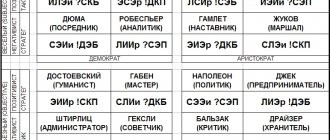The article explains:
- How a vision board works
- Algorithm for creating a vision board
- Filling out the sectors of the vision board
- Next steps with the vision board
A vision board is a tool that helps a person achieve what he dreams of. And there’s no smell of magic here, it’s all about psychology. If the concentration on a certain goal is strong enough, then the path to achieving it will be easier.
In principle, you can visualize your desires in different ways, but strictly following a method tested by many people is still preferable. It's like an algorithm for solving equations in algebra or proving theorems in geometry. It worked once, it will work again.
The concept of visualization in psychology, who is the founder of the technique?
Visualization is a tool that helps create correct and realistic mental images. There are many different visualization techniques used in psychology today, each designed based on a person's purpose and need.
The concept of visualization was first introduced by psychiatrist Carl Jung; he also developed the first visualization technique - active imagination, a method of working with subjective images in order to have a positive effect on consciousness.
Using additional practices
If meditation is not suitable for a person for some reason, he can use alternative practices, including visualization cards for wish fulfillment, magic spells, and repeated repetitions of settings. All of them are also carried out in a state of altered consciousness.
Simple meditation visualization
Let's take a closer look at the procedure:
- look at the burning candle for 3-5 minutes, completely relax, calm down;
- closing your eyes and turning on each of your senses, formulate a desire, the visualization of which is necessary;
- Having fixed it in the form of an image in a frame, gradually moving it away until it completely disappears, desires are released into the light, visualization of fulfillment occurs;
- leave the candle without extinguishing it until it burns out completely, and do the meditation for two weeks. New day - new candle.
Visualization Basics
The concept of visualization is used in different directions in psychology in order to solve a specific problem with:
- worldview;
- negative attitudes;
- emotional blocks of a person.
The very idea of visualization is very simple: using your imagination, you can create the necessary images and approaches to thinking in order to eliminate some unpleasant feeling or achieve the desired result.
Visualization in psychology
Typically in psychology, visualization is used as an auxiliary technique for an integrated approach to therapy. It guarantees a thorough study of the destructive problem and its origins, helps to choose the most optimal option and duration of visualization.
Video
Visualization in psychology is the construction of visual images in the head to change one’s worldview, negative subconscious attitudes and deep-seated irrational beliefs, in order to get rid of various emotional and psychological problems in life.
Visualization of desires , like positive affirmations, is not the magical fulfillment of any desires in reality, but the implementation of rational, logically based goals.
Today on the psychological help website Psychoanalyst-Matveev.RF you will learn how to correctly visualize using the visualization method and technique used in cognitive-behavioral and rational psychotherapy.
How and where can visualization be used?
Visualization techniques are used today in different directions:
- in cognitive psychology, as part of therapy;
- in meditation, as a means of increasing concentration, confidence and spiritual growth;
- in business, as part of the development of business processes and modeling situations.
Basically, researchers agree on the statement that visualization is a very effective technique that helps you change your own attitude towards life.
Regardless of the form of visualization, the most common is to use this technique in a calm, relaxed state for the following purposes:
- strengthening self-esteem;
- setting realistic goals and objectives;
- learning foreign languages;
- public speaking rehearsal;
- planning and decision making;
- strengthening your own values;
- eliminating bad habits;
- getting rid of negative beliefs;
- mastering a new skill;
- changing the way of thinking;
- maintaining motivation.
There are many ways to use visualization. The main principle of its correct use is a clear understanding of why to do it: there will be a positive outcome from visualization if you do it consciously, and not automatically. It is because of this failure that so many skeptics do not believe in the positive power of this technique.
Why does visualization work?
Visualization in psychology is the process of creating and consolidating in the mind positive images, sensations or desired reality. Psychologists explain the effectiveness of visualization by the fact that with regular practice it helps to change negative thinking, thereby increasing self-esteem, and also helps to adequately assess one’s own strengths and weaknesses, and to be less critical of oneself.
Such changes can be achieved through proper visualization and repeated rehearsal of the desired image, which purposefully changes subconscious patterns of behavior, while removing complexes, pressures and self-doubt. And for such visualization to work, it is necessary to adhere to the correct algorithm for its execution.
Algorithm for correct visualization
Scientists explain the effectiveness of visualization by the fact that the brain does not distinguish between reality and dreams at the neural level - for it these are pictures with the same stimulation of neurons.
Therefore, if you put together the right visualization algorithm and work it out regularly, the desired mental attitude, image or thinking will become part of the subconscious and give confidence in the future.
Correct formulation of desire
You need to understand that the possibility that the technique will work largely depends on the clarity of the formulation of the task - what exactly is visualized.
To get the desired result from visualization, you need to clearly understand what this practice is aimed at in a particular case: changing thinking, eradicating negative attitudes or an internal critic, increasing confidence in your own strengths, or developing an action plan. Each time, before starting visualization, you need to remind yourself what the purpose of this practice is.
It is equally important for visualization to relax, trust your inner intuition, your desire to change. If there is a strong rejection of the visualization process, you need to analyze your own needs, values and attitudes - usually the problem is hidden there.
Clear presentation of the final result
One of the important aspects of effective visualization is the clear presentation of the final result.
To do this, you need not only to create a detailed image in your head, a picture, but also to use your senses and feel:
- euphoria from winning;
- happiness joy;
- Gratitude;
- Confidence in your strength.
An equally important aspect is that it is strictly forbidden to visualize failure or defeat - you can only imagine the desired outcome.
Full immersion in a dream
Visualization in psychology is a mental technique of working with consciousness, where detail is an important aspect of correctly compiling the necessary image. Therefore, the mental picture that has arisen in the head must be supplemented with clear desires and sensations that will be felt in the process of achieving the goal.
If visualization is a house, then complete immersion in a dream is not just an idea of an abstract house, but a clear understanding of what kind of house it is, what sensations arise when walking through it, what kind of floors are there, how much space is there in the house, what smells are there, where to receive guests, what household chores need to be done.
Dynamic picture
Another important part of proper visualization is to imagine yourself in the process of work not from the outside, but as an active participant. The visualization picture should be dynamic - this means that you need to not only imagine yourself as successful, you also need to connect sensations and emotions, imagine how your own habits, voice and posture will change.
Choosing the right time for visualization
Psychologists are confident that to achieve results from visualization, you need to prefer regularity rather than rare but long-term practices. Therefore, a better approach to visualization is to make it part of your daily morning or evening routine.
Typically, visualization requires 10 to 20 minutes of daily practice. Psychologists recommend doing the technique at least once a day in a relaxed state.
Developing a Habit
You can develop the habit of regularly doing visualization in an average of 3 weeks. To take a responsible approach to developing this skill, you can determine the appropriate practice time and commit yourself not to miss classes.
It is also important to track your daily progress to develop the habit of proper visualization:
- was there any improvement?
- what was the emotional state during the visualization;
- where difficulties arose.
How to develop energy in consciousness
Due to the fact that the practice of visualization takes place in a relaxed state and always involves the formation of a positive mental image of the desired result, the longer you practice, the more it will develop and fill the consciousness with energy, which will help keep vital forces in the desired balance and increase stress resistance.
Visualization is an effective way to develop positive energy in the mind, which is used in psychology as a means of changing negative attitudes in the mind.
Learning to visualize
To learn how to visualize, I will offer you one interesting technique. This visualization method consists of several parts, designed to be completed in two stages of five days (it is given in the book “Getting Help from the Other Side Using the Silva Method” by Jose Silva and Robert Stone).
Day by day it helps to reach new levels of visualization development and create increasingly clear, bright and voluminous images.
Visualization development technique. The first day
In the afternoon, go to the alpha level and imagine a large green watermelon.
Then imagine someone cutting it in half and it splits into two halves. Note how the cut halves look. Then imagine putting the halves together and making them disappear.
Return from the visualization development technique to your normal state. Remember what the halves of a cut watermelon looked like in your imagination.
Was the watermelon ripe or not so ripe?
What shade of red did you see?
What size and color were the seeds?
Note that the assignment did not say that you should see all these details - your imagination did this work itself.
On the subject: How to choose the right pictures for a wish map and visualizations
Visualization development technique. Second day
Go to the alpha level and imagine what your reflection looks like in the mirror.
Mentally look at your face and see your facial features as clearly as possible.
If this is not immediately successful, return to your normal state, look at yourself in the mirror, trying to remember, and make another attempt to visualize your appearance.
Visualization development technique. Day three
Go to the alpha level and visualize one of your loved ones, friends or acquaintances - someone you know well.
Try to clearly imagine the face.
If you have difficulty remembering faces, before the exercise, take a good look at this person and try to remember his appearance well, down to the details.
Visualization development technique. Day four
Remember some quiet, peaceful place in nature where you have been and felt good and comfortable there.
Enter the alpha state and visualize this place.
In the video below I talk about a simple way to reach the alpha level.
Then learn to visualize yourself there. Imagine that you were actually transported there. Let the picture be as real as possible.
Experience again the calm and comfortable state that you experienced there. If this helps you calm down and relax, you can later mentally transport yourself to this place for relaxation and work at the alpha level.
Visualization development technique. Day five
Take a good look at your home and what it looks like from the outside.
Then go to the alpha level and visualize it.
Mentally reproduce all the smallest details, color features, wall textures, etc. - the more detailed you imagine your home, the better.
Visualization exercises for the following days
Over the next five days, these methods of visualizing desires are repeated in a slightly modified form, as a result of which some of them will help not only learn proper visualization, but also make positive changes in your life.
1. When performing the watermelon visualization technique, imagine not only its appearance, but also its smell and taste. Then let the watermelon disappear and repeat the same with the lemon; onion, any fruit or vegetable as desired.
2. When performing the technique of visualizing yourself in the mirror, imagine yourself younger, healthier, cheerful and energetic.
3. Visualizing a friend or relative, mentally forgive him all insults, conflicts and misunderstandings and imagine how you yourself will ask him for forgiveness.
4. When performing the technique of visualizing a quiet, calm place, imagine yourself in it as strong, confident, healthy, rich, prosperous, capable of creative activity to transform the world for the better.
5. Visualizing the house, mentally surround it with white light and imagine that this is the light of love and protection in which you are constantly.











